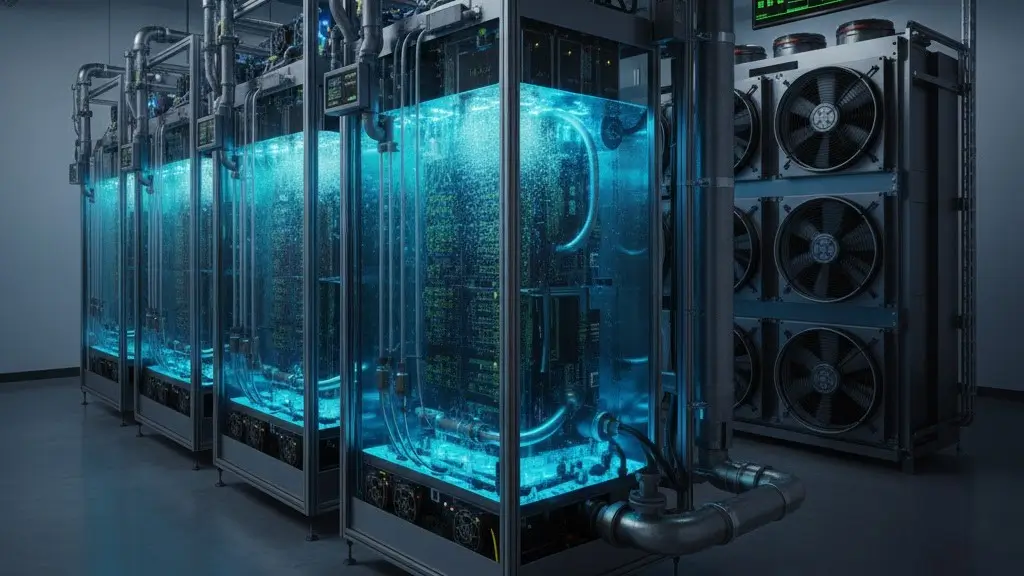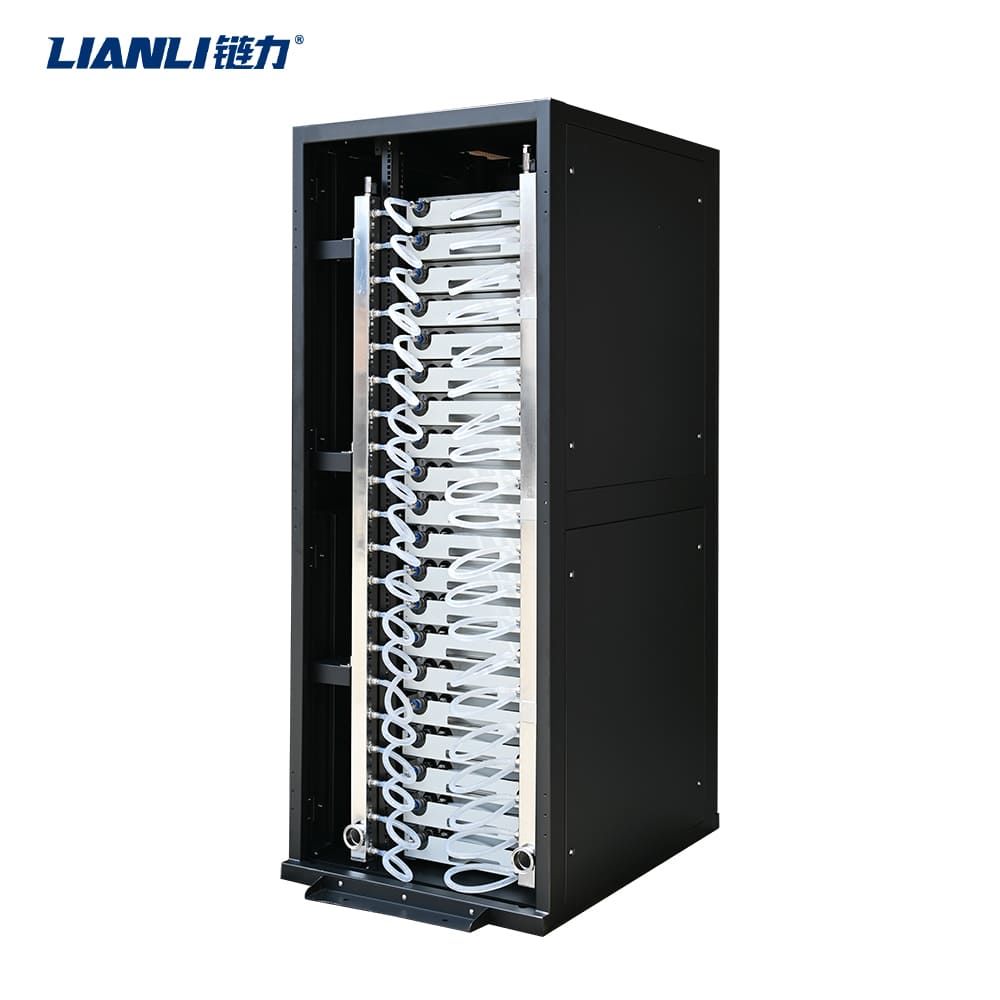Best Crypto Mining Liquid Cooling System Complete Guide
2025年10月13日
Crypto mining hardware — from high-end GPUs to industrial-grade ASIC rigs — generates intense heat under constant load. When cooling is inefficient, that heat leads to throttling, hardware degradation, and wasted energy. For advanced miners, upgrading to a crypto mining liquid cooling system is one of the most effective ways to maintain peak performance, reduce noise, and extend hardware lifespan.
This article explores how crypto mining liquid cooling works, its advantages over air cooling, and what to consider when choosing or building the best crypto mining liquid cooling system for your operation.

Why Cooling Matters in Crypto Mining
Every hash counts. But behind each calculation is a chip producing enormous heat. Modern GPUs can consume 300–600 W, while ASIC miners like the Antminer S19 can exceed 3,000 W of power draw.
That heat must go somewhere — and in tightly packed mining setups, air cooling often isn’t enough. Fans can only move so much heat, and once ambient temperatures rise, efficiency drops sharply.
Overheating leads to:
Lower hash rates due to thermal throttling
Shorter hardware lifespan
Higher failure rates and downtime
Increased electricity use from additional fans and HVAC systems
Air cooling systems also create noise levels exceeding 80 dB — comparable to a vacuum cleaner — and require constant maintenance to prevent dust buildup. For advanced miners seeking performance and longevity, these drawbacks make liquid cooling a compelling alternative.
How Crypto Mining Liquid Cooling Systems Work
A crypto mining liquid cooling system replaces the traditional fan-and-heatsink setup with a closed liquid loop that absorbs and disperses heat far more efficiently.
Core Components
Cold Plates / Water Blocks – Attached directly to GPUs or ASIC chips, these absorb heat from the components and transfer it to the coolant.
Pump – Circulates the coolant through the loop, ensuring continuous heat removal.
Radiator – Releases absorbed heat into the air using fin stacks and fans.
Reservoir – Stores excess coolant and helps remove trapped air bubbles.
Coolant – A specially formulated liquid (often deionized water or glycol mix) with corrosion inhibitors to maintain conductivity and prevent oxidation.
The Process
The pump pushes coolant through the cold plates, drawing heat away from the chips. The hot liquid flows to the radiator, where fans disperse the heat into the surrounding air. The cooled liquid then returns to repeat the cycle.
This closed-loop process keeps temperatures stable even under heavy loads, allowing miners to maintain high hash rates and extend component life.
Liquid Cooling vs. Air Cooling
| Factor | Air Cooling | Liquid Cooling |
|---|---|---|
| Heat Transfer | Limited by airflow; prone to hot spots | Highly efficient; absorbs and transfers heat faster |
| Noise Levels | Loud (especially ASIC farms) | Quiet and smooth operation |
| Energy Efficiency | High cooling overhead | Lower energy use per watt of heat removed |
| Maintenance | Dust removal, fan replacement | Periodic coolant checks, pump inspection |
| Scalability | Space and airflow limited | Supports higher hardware density |
| Longevity | Fans wear out faster | Hardware runs cooler and lasts longer |
Performance Advantages
Superior Thermal Conductivity: Water transfers heat roughly 25x faster than air.
Stable Temperatures: Liquid loops prevent the wild temperature swings that damage silicon.
Quieter Operation: No need for industrial fan arrays — just a gentle pump hum.
Overclocking Potential: Cooler chips can safely run at higher frequencies.
However, liquid cooling is not without trade-offs. It requires a higher upfront cost, more setup time, and regular maintenance to prevent leaks or coolant degradation.
Challenges and Considerations
Before adopting liquid cooling, advanced miners should account for several practical factors:
1. Installation Complexity
Liquid systems demand precision. Fittings, tubing, and cold plates must be perfectly sealed to prevent leaks. Even a small air bubble can disrupt cooling performance.
2. Maintenance
Coolant should be replaced or flushed periodically. Radiators and pumps need occasional inspection to ensure smooth operation. Neglect can lead to algae growth or corrosion.
3. Cost
A full-scale liquid setup costs more upfront — especially with multiple GPUs or ASICs — but pays off through reduced downtime, energy savings, and longer hardware life.
4. Reliability
A failed pump can quickly cause overheating. Use high-quality pumps and temperature monitoring tools to mitigate this risk.
5. Leak Prevention
Modern mining-grade liquid cooling systems use non-conductive coolant and negative-pressure designs to minimize leak risks, but careful setup is still critical.
Long-Term Benefits of Crypto Mining Liquid Cooling
When implemented properly, crypto mining liquid cooling delivers multiple long-term advantages:
Enhanced Stability – Constant operating temperatures reduce stress on components.
Higher Hash Rates – Cooler chips can sustain higher frequencies for longer.
Reduced Noise – A quieter environment makes mining more manageable at home or in data centers.
Energy Efficiency – Lower cooling power consumption reduces operational costs.
Longer Lifespan – Hardware operates under less thermal stress, reducing replacement frequency.
Advanced users even leverage liquid cooling for safe overclocking, unlocking extra performance potential. A properly cooled GPU can achieve 5–10% higher hash rates without throttling.
For ASICs, liquid-cooled configurations can reach densities far beyond what air cooling allows — maximizing hashrate per rack and improving ROI.
Choosing the Best Crypto Mining Liquid Cooling System
The best crypto mining liquid cooling system depends on your setup size, budget, and performance goals. Look for:
High-flow pumps and large radiators capable of handling multi-kilowatt loads
Custom cold plates designed for your specific GPUs or ASIC models
Quality tubing and fittings with reliable seals
Smart controllers for monitoring pump speed and coolant temperature
Non-conductive coolant for added safety
Some brands now offer pre-built or modular systems tailored for mining. For instance, Lian Li provides dedicated cooling racks that integrate radiators, pumps, and coolant distribution for ASIC miners — optimized for both performance and silent operation.

Final Thoughts
Liquid cooling has evolved from a niche enthusiast solution to a cornerstone of professional mining infrastructure. For advanced users, it offers:
Higher sustained performance
Lower operational noise
Better long-term ROI through hardware longevity and energy efficiency
While it requires more care and investment upfront, a properly designed crypto mining liquid cooling system transforms the way your rigs perform and survive in today’s competitive mining landscape.
Whether you’re managing a compact GPU setup or a large ASIC farm, transitioning from fans to fluid cooling may be the smartest upgrade you make for stable, efficient, and quiet mining.
FAQs: Crypto Mining Liquid Cooling Systems
1. What is the best crypto mining liquid cooling system for ASIC and GPU rigs?
The best crypto mining liquid cooling system depends on your setup’s scale and power demands. For large ASIC farms, high-capacity radiators and industrial-grade pumps are ideal. For GPU miners, modular liquid cooling kits with individual cold plates offer flexibility and efficient heat dissipation. Always choose non-conductive coolant and robust fittings to ensure reliability.
2. Is a crypto mining liquid cooling system better than air cooling?
Yes. A crypto mining liquid cooling system offers superior heat transfer efficiency, quieter operation, and better long-term performance compared to air cooling. While it requires a higher initial investment and occasional maintenance, it allows miners to achieve stable temperatures, improved energy efficiency, and even safe overclocking potential for higher hash rates.
3. How does crypto mining liquid cooling improve mining efficiency?
Crypto mining liquid cooling enhances mining efficiency by maintaining consistent chip temperatures, reducing fan power consumption, and preventing thermal throttling. The result is a more stable hash rate, longer hardware lifespan, and lower overall power costs — making it a valuable upgrade for advanced miners focused on maximizing ROI.
previous page
Recommended news
Looking for a crypto mining container for sale? Compare crypto mining containers, cooling types, capacity, and real deployment tips. Find the best crypto mining containers for sale for mining farms in 2025.
The five major factors behind the December crash in Bitcoin price and why BTC may continue facing downward pressure. A clear for investors, traders, and crypto analysts.















